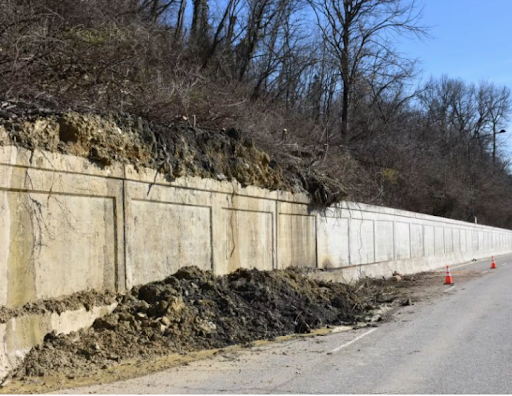Undulating topography is one thing that Cincinnati residents love most about their hometown. But hillsides can also pose dangerous liabilities if not protected against erosion.
The spread of invasive plants, along with the higher frequency of heavy rain events in recent years, has caused a number of landslides in the Cincinnati area. Experts are recommending that homeowners take a proactive approach to protecting their hillsides against erosion.
One effective action? Removing invasive honeysuckle and replacing it with native plants. Read on to learn why.
A large landslide along Columbia Parkway. Photo credit: WVXU
The Problem
Annual precipitation has increased 5 to 10% since 1950, according to a Cincinnati Government agency. Much of this increased rainfall has come in the form of intense downpours, which are difficult for areas prone to erosion.
This comes at a time when the spread of invasive plants such as Bush Honeysuckle is out-competing native species and decreasing biodiversity in certain areas.
The most protected hillside is one with multiple plant species that work together to create a deep, interlocking network of roots to hold the soil in place.
Bush Honeysuckle undermines the integrity of hillsides in two major ways:
Honeysuckle is very shallowly rooted, making it unsuitable for stabilizing hillsides and preventing erosion.
Honeysuckle is allelopathic, meaning it excretes chemicals from its roots that prevent other seeds from germinating in its proximity. This prohibits the creation of a multi-layered, diverse network of roots that hillsides need to remain intact.
Because honeysuckle grows so quickly and out-competes other plants, it often thrives on recently disturbed sites. Many new construction projects unknowingly clear the way for honeysuckle to take hold by clearing native plants during the Site Preparation phase of construction.
As more and more biodiverse areas are being developed, honeysuckle is spreading at aggressive rates. For many Cincinnati residents, this could present a future risk of erosion and resulting property damage.
Photo credit: Cincinnati Enquirer
The Solution
To protect your home from risks associated with erosion, Aaron Habig of the Hamilton County Conservation District recommends removing honeysuckle and replacing it with native trees and shrubs.
Another research project, which combined work from the Universities of Cincinnati and Kentucky, also urges homeowners to remove and replace honeysuckle with native trees and shrubs.
A number of native plants are very well suited for slope stabilization. Plants such as Elderberry, Maple, Oak, and Spicebush will do a much better job of stabilizing soil on slopes and creating a deep, interlocking network of roots to prevent erosion.
A steep hillside is protected from erosion by removing invasive honeysuckle and adding native plants and terracing (Our Land Organics design & installation)



